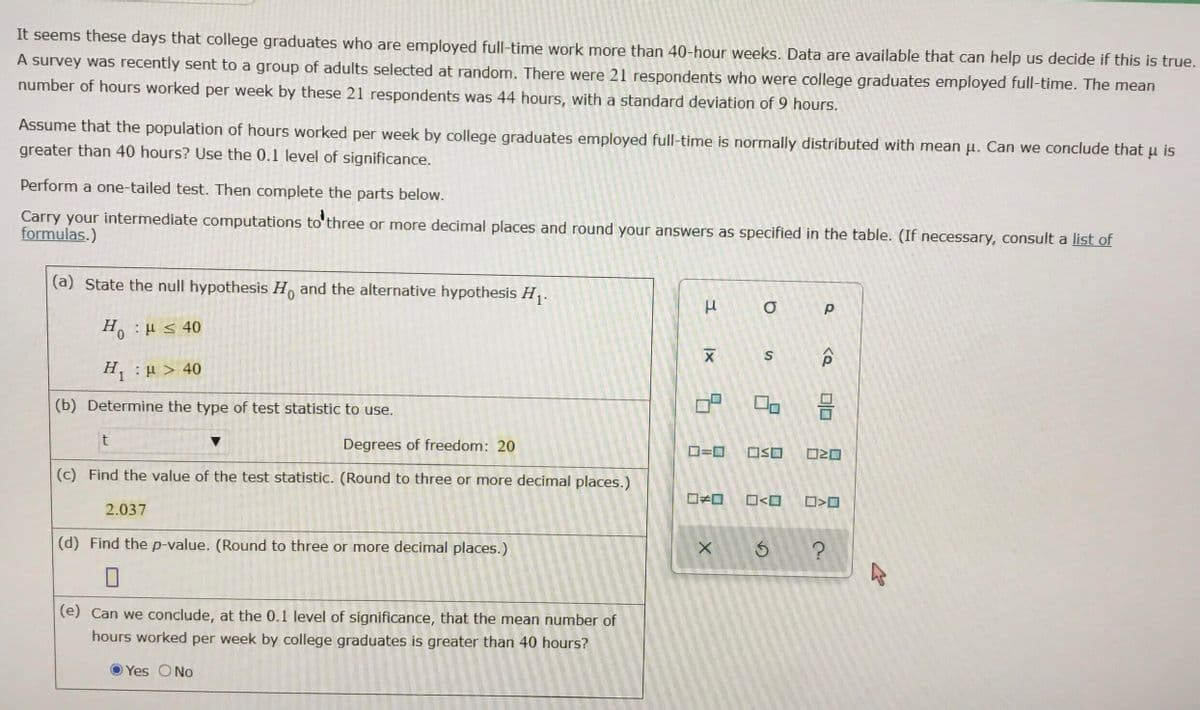It seems these days that college graduates who are employed full-time work more than 40-hour weeks. Data are available that can help us decide if this is tru A survey was recently sent to a group of adults selected at random. There were 21 respondents who were college graduates employed full-time. The mean number of hours worked per week by these 21 respondents was 44 hours, with a standard deviation of 9 hours. Assume that the population of hours worked per week by college graduates employed full-time is normally distributed with mean u. Can we conclude that u is greater than 40 hours? Use the 0.1 level of significance. Perform a one-tailed test. Then complete the parts below. Carry your intermediate computations to'three or more decimal places and round your answers as specified in the table. (If necessary, consult a list of formulas.) (a) State the null hypothesis H and the alternative hypothesis H. H. : Hs 40 H, :H > 40 (b) Determine the type of test statistic to use. t Degrees of freedom: 20 D=0 OSO O20 (c) Find the value of the test statistic. (Round to three or more decimal places.) 2.037 (d) Find the p-value. (Round to three or more decimal places.) oln
It seems these days that college graduates who are employed full-time work more than 40-hour weeks. Data are available that can help us decide if this is tru A survey was recently sent to a group of adults selected at random. There were 21 respondents who were college graduates employed full-time. The mean number of hours worked per week by these 21 respondents was 44 hours, with a standard deviation of 9 hours. Assume that the population of hours worked per week by college graduates employed full-time is normally distributed with mean u. Can we conclude that u is greater than 40 hours? Use the 0.1 level of significance. Perform a one-tailed test. Then complete the parts below. Carry your intermediate computations to'three or more decimal places and round your answers as specified in the table. (If necessary, consult a list of formulas.) (a) State the null hypothesis H and the alternative hypothesis H. H. : Hs 40 H, :H > 40 (b) Determine the type of test statistic to use. t Degrees of freedom: 20 D=0 OSO O20 (c) Find the value of the test statistic. (Round to three or more decimal places.) 2.037 (d) Find the p-value. (Round to three or more decimal places.) oln
Glencoe Algebra 1, Student Edition, 9780079039897, 0079039898, 2018
18th Edition
ISBN:9780079039897
Author:Carter
Publisher:Carter
Chapter10: Statistics
Section10.3: Measures Of Spread
Problem 26PFA
Related questions
Topic Video
Question
Hi,
I am having trouble finding the P-value for this problem. Could you please explain step by step how will I figure out the P-value? Thanks.

Transcribed Image Text:It seems these days that college graduates who are employed full-time work more than 40-hour weeks. Data are available that can help us decide if this is true.
A survey was recently sent to a group of adults selected at random. There were 21 respondents who were college graduates employed full-time. The mean
number of hours worked per week by these 21 respondents was 44 hours, with a standard deviation of 9 hours.
Assume that the population of hours worked per week by college graduates employed full-time is normally distributed with mean u. Can we conclude that u is
greater than 40 hours? Use the 0.1 level of significance.
Perform a one-tailed test. Then complete the parts below.
Carry your intermediate computations to'three or more decimal places and round your answers as specified in the table. (If necessary, consult a list of
formulas.)
(a) State the null hypothesis H, and the alternative hypothesis H.
H. : H < 40
H : μ> 40
(b) Determine the type of test statistic to use.
Degrees of freedom: 20
D=0
OSO
(c) Find the value of the test statistic. (Round to three or more decimal places.)
O<O
2.037
(d) Find the p-value. (Round to three or more decimal places.)
(e) Can we conclude, at the 0.1 level of significance, that the mea
number of
hours worked per week by college graduates is greater than 40 hours?
Yes ONo
Expert Solution
This question has been solved!
Explore an expertly crafted, step-by-step solution for a thorough understanding of key concepts.
This is a popular solution!
Trending now
This is a popular solution!
Step by step
Solved in 2 steps with 2 images

Knowledge Booster
Learn more about
Need a deep-dive on the concept behind this application? Look no further. Learn more about this topic, statistics and related others by exploring similar questions and additional content below.Recommended textbooks for you

Glencoe Algebra 1, Student Edition, 9780079039897…
Algebra
ISBN:
9780079039897
Author:
Carter
Publisher:
McGraw Hill

Glencoe Algebra 1, Student Edition, 9780079039897…
Algebra
ISBN:
9780079039897
Author:
Carter
Publisher:
McGraw Hill